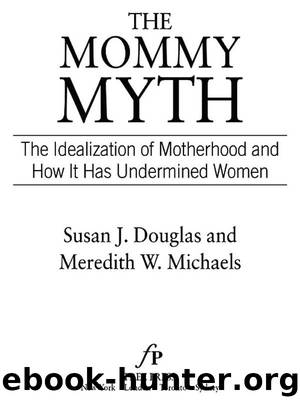The Mommy Myth: The Idealization of Motherhood and How It Has Undermined Women by Susan Douglas & Meredith Michaels

Author:Susan Douglas & Meredith Michaels [Douglas, Susan]
Language: eng
Format: azw3
Publisher: Free Press
Published: 2004-03-26T05:00:00+00:00
By the late 1980s and early 1990s, a much less sympathetic stock character increasingly overshadowed both the “queen” and the born-again workfare mom in the news: the unwed teenager who, whoops, had a baby and then, whoops, had another and made the decent taxpayers of America pay through the schnozz forever for her seconds of unprotected, thoughtless pleasure with some irresponsible, layabout black boy, himself increasingly stereotyped on reality shows like COPS and 911 as a drug-dealing criminal. At first, in the mid-1980s, most stories about welfare mothers and unwed teen mothers were in separate categories. The “epidemic” of teen pregnancies was illustrated by visits to high school programs designed to keep girls in school, and we saw a fair mix of black and white teens. But when the stories talked about some of these girls going on welfare, invariably the face that we saw was black.54 And gradually these stories merged into one giant pathology of a metastasizing welfare system pushed to its limits by irresponsible, oversexed black girls.
Even though only 1.2 percent of welfare mothers were under eighteen when they received benefits, and teens accounted for about 5 percent of welfare caseloads, the unwed teen, preferably one whose mother and grandmother had also been unwed teen mothers on welfare for life, was to conservative politicians and the networks what Princess Diana was to People magazine: a constant attention grabber.55 We first met her in 1985, when NBC introduced us to Gloria from Cabrini Green in Chicago, who was born when her mother was sixteen and first became pregnant herself at fourteen. She, her two kids, and her mother were all on welfare, and it was here that we may have first heard the phrase “children raising children.” These children were “trapped in a cycle of crime, isolation, and welfare.” The term “culture of dependency” (which suggested that poor black mothers were inherently shiftless and unproductive and, as with sickle-cell anemia, they transmitted this diseased, deviant lifestyle to their vulnerable offspring) became a part of the new common sense about welfare.
Now, most people agree that it is not a good idea for fourteen-year-olds to have babies. But really, what were Americans thinking? Take one large teenage population, inundate them with barely clad models in Calvin Klein ads, characters on soap operas who live to hump, sitcoms at 8:00 P.M. (the old “family viewing hour”) with jokes about odd-shaped penises, masturbation, and hookers, bumping and grinding movie videos with giant boobs and stuffed crotches, prime-time soaps like Melrose Place where everyone really was in bed 24/7 with whoever was handy (they, like, wrote memos and sealed mergers in bed), news “documentaries” like NBC’s “Scared Sexless” (1987), romanticized depictions about getting swept away by passion, and the never-ending acts of copulation in the movies, and you are kind of conveying a relentless message that sex is the nation’s most popular recreational activity and the one that confirms that you are attractive, worthwhile, and cool. Simply put, beginning in the 1980s, the media seriously overemphasized the importance of sex in everyday life.
Download
This site does not store any files on its server. We only index and link to content provided by other sites. Please contact the content providers to delete copyright contents if any and email us, we'll remove relevant links or contents immediately.
Should I Stay or Should I Go? by Ramani Durvasula(7563)
The Lost Art of Listening by Michael P. Nichols(7407)
The Rosie Project by Graeme Simsion(6191)
Beartown by Fredrik Backman(5599)
We Need to Talk by Celeste Headlee(5544)
Ego Is the Enemy by Ryan Holiday(5294)
Hunger by Roxane Gay(4869)
Suicide Notes by Michael Thomas Ford(4764)
I Love You But I Don't Trust You by Mira Kirshenbaum(3807)
Mummy Knew by Lisa James(3634)
Not a Diet Book by James Smith(3336)
Crazy Is My Superpower by A.J. Mendez Brooks(3329)
Toxic Parents by Susan Forward(3224)
Girl, Wash Your Face by Rachel Hollis(3210)
The Complete Idiot's Guide to Coping With Difficult People by Arlene Uhl(3116)
The Social Psychology of Inequality by Unknown(2940)
Name Book, The: Over 10,000 Names--Their Meanings, Origins, and Spiritual Significance by Astoria Dorothy(2939)
The Hard Questions by Susan Piver(2926)
The Gaslight Effect by Dr. Robin Stern(2739)
